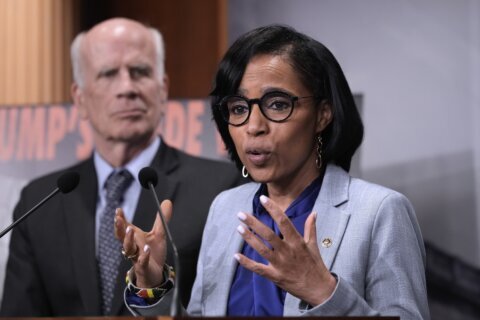This article was republished with permission from WTOP’s news partners at Maryland Matters. Sign up for Maryland Matters’ free email subscription today.
This content was republished with permission from WTOP’s news partners at Maryland Matters. Sign up for Maryland Matters’ free email subscription today.
Tracking the health of the Chesapeake Bay is a massive undertaking. It involves multiple agencies in federal, state and local governments monitoring the health of the air, land and water, of trees, vegetation and aquatic life.
Measuring Bay health can also become a mind-numbing amalgam of statistics and reports, most designed to gauge how Maryland and the six other Bay jurisdictions — Virginia, West Virginia, Pennsylvania, Delaware, New York and the District of Columbia — are progressing to meet federal pollution control standards.
Still others chart the economic health of the Bay region and its key industries. Government officials who focus on the Bay interact routinely with farmers, watermen, scientists, environmentalists and the tourism industry.
The start of a new administration in Annapolis brings a fresh set of leaders tasked with steering Bay protection efforts in Maryland — working, in many cases, with some old hands.
And in a rarity, they were all on hand in the House Environment and Transportation Committee hearing room in Annapolis Wednesday, introducing themselves to lawmakers, in some cases, and offering their takes on the health of the Bay.
So what was the lineup of officials and other leaders testifying?
There was Serena McIlwain, Gov. Wes Moore’s pick to become secretary at the Maryland Department of the Environment. There was Josh Kurtz, the Moore administration’s nominee to be secretary at the Department of Natural Resources. And Kevin Atticks, the Agriculture secretary-designate. All were accompanied by lieutenants who have been at their agencies for a while.
Also testifying: Mark Hoffman, the Maryland director of the Chesapeake Bay Commission, a body of legislative leaders from Maryland, Virginia and Pennsylvania, and his new boss, Anna Killius, the commission’s executive director.
The Chesapeake Bay Foundation was also on hand, with Erik Fisher, its acting director (a position Kurtz held until recently), and Matthew Stegman, the foundation’s Maryland counsel, testifying.
The Chesapeake Bay Foundation recently gave a D-plus grade for the Bay’s health. A slightly older study, from the University of Maryland Center for Environmental Science, put the grade at C-plus. But several leaders said the grades only tell part of the story.
“Bay water quality is improving,” Hoffman said. “It’s not as much as we’d like. It’s not as fast as we’d like. But it’s improving with all the growing population.”
Del. Kumar Barve (D-Montgomery), chair of the Environment and Transportation Committee, said the report cards don’t reflect all the work that has gone into cleaning up the Bay.
“I don’t believe this D-plus grade bears very well with the people in this room,” he said.
In recent months, the U.S. Environmental Protection Agency has conceded that some states will fall short of meeting their pollution reduction goals that were supposed to be in effect by 2025.
Speaking to a Maryland environmental summit Tuesday night, Kandis Boyd, director of the EPA’s Chesapeake Bay Program, said 2025 still represents “an opportunity” for states to move as quickly as they can to meet their mandated goals — and to think in even more sweeping ways about the future.
McIlwain on Wednesday said Maryland has been making “steady progress” in the reduction of its wastewater load, though the trend was reversed in 2021 following sewage spills at the Back River and Patapsco wastewater treatment plants. Baltimore-area officials on Tuesday announced their plans to seek a new management structure for the region’s water and sewer utilities.
McIlwain also said she expects a resolution soon to a lawsuit Maryland, Virginia and Washington, D.C., filed against the EPA in 2020 for failing to adequately police Bay pollution originating in upriver states like Pennsylvania and New York.
“They are right in the middle of getting it settled,” she said.
McIlwain and her fellow cabinet members — each of whom has yet to be confirmed by the state Senate — laid out some of the efforts their agencies are making to ensure the Bay’s health continues to improve.
Those efforts range from staffers at the Department of Agriculture who work regularly with farmers to the dozens of water monitors that the Department of Natural Resources maintains throughout the state. Several lawmakers asked questions about the Conowingo Dam, where sediment from farms in Pennsylvania and New York enters the Bay through the Susquehanna River.
“The talent and dedication in this room gives me a lot of hope for the future of the Bay,” said Del. Sheila Ruth (D-Baltimore County), a member of the Environment and Transportation panel.
Many of the same leaders are scheduled to appear together again Thursday afternoon, for a briefing in the Senate Education, Energy and Environment Committee.
Editor’s note: Josh Kurtz, the nominee to be secretary of Natural Resources, is no relation to the Maryland Matters reporter of the same name.







